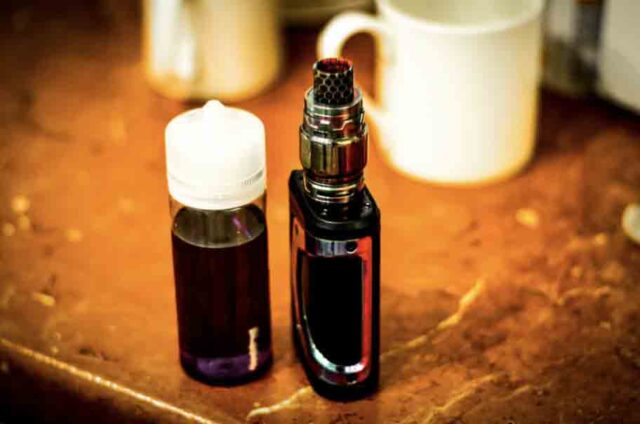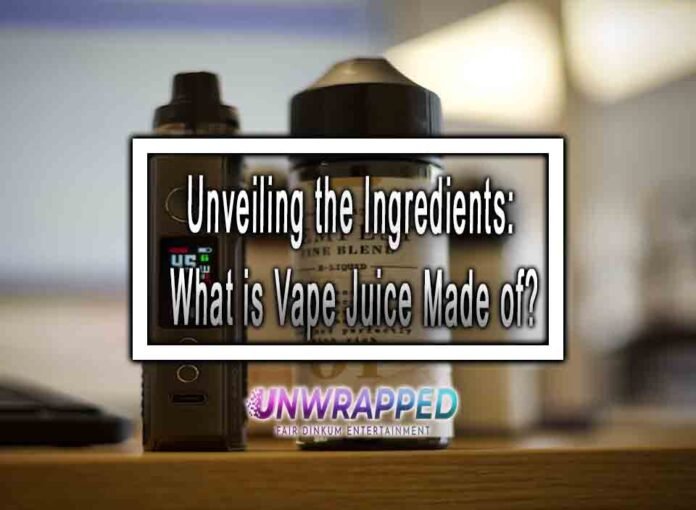The material that resides inside a vape pen or any vaping device gives it its distinctive flavor and aroma, which is vape juice. Vape juice comes in a rainbow of colors, a wide variety of flavors, and dozens of reputed brands. Having some idea of the components of vape juice will go a long way toward helping you select the best vape juice taste for your needs.

Vape juice, often known as e-liquid, comprises four basic components: a base of propylene glycol or vegetable glycerin, water, nicotine, and flavorings. These are the four main ingredients in vape juice. Vape juice needs a base. These substances act as humectants, which means they help keep water around for longer. The base of your vape is the majority of it.
In this article, we will discuss exactly what vape juice is made of.
What are the Ingredients of Vape Juice?
Vape juice is made up of five basic ingredients:
- Vegetable Glycerin (VG)
- Propylene Glycol (PG)
- Flavorings
- Nicotine
- Water
Propylene glycol and vegetable glycerin are used in vape juice or e-liquids as their base ingredients. A On the other hand, special Max VG or PG vape liquids can contain as much as 99% of VG or PG.
About 10–18 percent of e-liquid is water, flavoring concentrates, and nicotine. Percentage differences will be unique to each flavor of e-liquid. For instance, nicotine salts may account for 10%–30% of the e-liquid’s total volume. Air factory e-juice is a good example.
Here are the main ingredients of vape juice and what they contribute to the overall product, and what are their roles as ingredients of vape juice-
Propylene Glycol or PG
Whether synthesized in a lab from propylene oxide or naturally occurring, propylene glycol is an odorless, colorless, slightly viscous liquid. Many different types of food, drinks, and e-liquids rely on PG as an ingredient. One of PG’s primary roles in vape juice is to prevent the chemicals from settling to the bottom of the bottle after storage.
It is used in vape juices because it attracts and holds moisture. Due to this, your e-liquid will retain its vapor quality even after being exposed to air. Due to its high solubilizing capabilities, it is the primary transporter of the e-juice flavor or nicotine.
Some vape juices provide a burning feeling or throat hit because of the presence of PG. Vape liquids may be stored longer without going bad since they inhibit the growth of microorganisms. Thanks to its exceptionally low freezing point, PG is also useful as an antifreeze agent in e-liquids.
Vegetable Glycerin or VG
Vegetable glycerin (VG) is a naturally occurring substance that is both odorless and mildly sweet. It’s a thick liquid that’s much more viscous than PG. Glycerin is a chemical derived from various fats, both plant and animal. But the glycerin used in the vaping business comes exclusively from vegetable fats, hence the name vegetable glycerin.
Like PG, vegetable glycerin (VG) is a fundamental component of vape juice. Among these capabilities are:
- Among the many components in e-liquid, it acts as an emulsifier.
- Having humectant properties (the ability to absorb and hold onto moisture)
- Serving as a vehicle for the numerous flavors
- Having microbial effects
VG also serves a few other important purposes:
Forming Vape Clouds
Regarding the formation of cloudy vapor, VG is the primary element responsible. The greater the volume of vapor created by an e-liquid, the higher its VG content should be.
Working as a Sweetener
Because of its natural sweetness, VG acts as a sweetener to enhance the flavor and taste of vape juice. Its usage eliminates the need for sucrose and other artificial sweeteners.
What Is the Ideal PG/VG Ratio?
The effects of vape juice vary depending on the VG/PG ratio used. These effects are observable in the vape’s aftertaste, flavor, harshness, and cloud density. Vapers’ most common vape juice ratios are 70VG/30PG and 50VG/50PG. Here are some guidelines to help you determine the ideal PG/VG ratio:
Your own style of vaping
Do you enjoy massive cloud production, or do you want intense flavors with a noticeable throat hit? High VG blends are ideal for “cloud chasers,” whereas high PG blends are better for “flavor chasers.” Similarly, sub-ohm vaping benefits most from high-VG juices.
Condition of your health
Some people are sensitive to the hard throat hit that high-PG e-liquids provide, even though they are suggested for people trying to stop smoking. Therefore, those with a PG allergy should only use high-VG liquids.
The vape device you use
However, high-wattage devices with sub-ohm tanks are best for high-VG blends, and most electronic cigarettes are only suitable for high-PG ratios.
Nicotine
Most vape juice contains nicotine. Through vaping, you can get your nicotine fix without firing up tobacco leaves, so it is a great alternative to smoking. If you value a satisfying throat hit, you may want to experiment with e-liquids with a higher nicotine count. Despite its negative reputation, nicotine is a very harmless substance. It is cigarette smoke itself that is harmful. Although vaping poses little risk of poisoning yourself, high doses can actually be toxic for you.
You’ll start to feel queasy and sick long before you reach a harmful level. Vapers (and smokers) are experts at dosing themselves with the exact amount of nicotine they require. Any e-liquid that doesn’t strictly adhere to these four elements should probably be avoided. Flavorings have been carefully chosen for inhalation safety, whereas vitamins, colors, and supplements like caffeine have not.
What Nicotine Level is Best and How to Find It?
The nicotine concentration of most vape liquids is extremely low (often around 2%), allowing users to indulge in the hobby without risking an overdose. However, not all vapers find these fluids to their liking. Here are two considerations that should influence your decision about nicotine strength:
Cravings for nicotine
Vape juices with high nicotine levels are your best bet to quell your nicotine cravings immediately. However, low or zero-nicotine vape juices are suggested if your only goal is to enjoy the vapor and flavor that vaping provides.
Details on your smoking history
If you’re trying to kick the habit, your nicotine intake likely mirrors your dependence on cigarettes. High-nicotine e-liquids or nicotine salts will fulfill the nicotine cravings of a former six-pack-a-day smoker. On the other hand, if you are a typical smoker, low-nicotine vape liquids should suffice.
Flavorings
All vape juices utilize food-grade flavorings. Combining PG and VG with food flavorings can create sweet and strong flavors. PG and VG don’t produce many flavors on their own.
Vape juice flavorings can’t make up more than 10% of the liquid and typically sit closer to 3-7%. Mixing and matching several flavoring concentrates is common practice to create a new flavor (particularly a fruit flavor). Popular flavors of e-liquid include:
- Tobacco
- Strawberry
- Menthol
- Banana
- Watermelon
- Custard
- Bubblegum
Water
To ensure consistency and facilitate the blending of the PG, VG, and flavorings, vape liquids always include water. It’s also useful for making vapor that sticks around for a while. E-liquids have very low (close to zero) amounts of water.
Other Ingredients in Vapes
You’ll usually find PG, VG, flavors, nicotine, and water in vape juice. Cartridge-style electronic cigarettes, however, may also contain the following:
- Aldehydes
- Metals (like nickel and tin)
- Volatile organic compounds (VOCs)
- Tobacco alkaloids
- Aromatic hydrocarbons
Tobacco, carbon monoxide, and tar are not components of vape juice. This contrasts with regular cigarettes, which might include all these components.
Final Words
You may be perusing these supplies and thinking, “Hey, I can probably make my own!” While it is possible to manufacture your own vape juice at home, doing so properly calls for several things, including but not limited to the necessary equipment, ingredients, measures, flavor concentrates, and more. If your homemade vape juice is intentionally or accidentally loaded with something inappropriate, you risk major issues because vaping delivers the vape juice directly to the lung.
Most premium vape juice is incredibly pure, made with rigorous quality assurance testing, and has few additives beyond the essentials. Ultrafine particles absorbed directly into the lungs, problematic flavorings, volatile chemical compounds, and heavy metals like nickel are some of the substances found in low-quality vape juice. Therefore, it is essential that you only purchase vape juice from a reputable store or website, especially those that sell products made by popular and trusted e-liquid brands, so that you can be sure of the quality of the product you’re getting.










